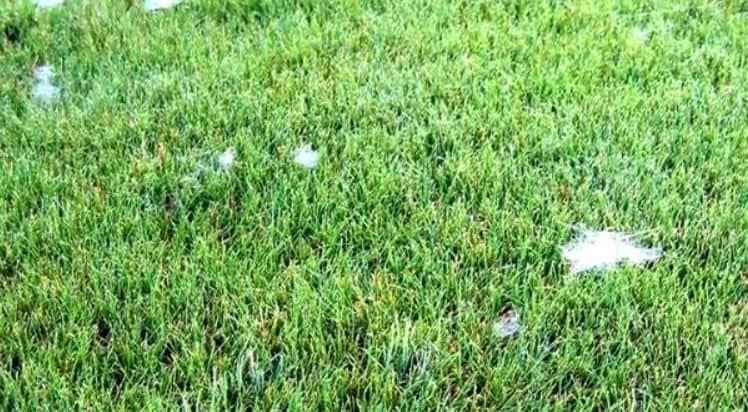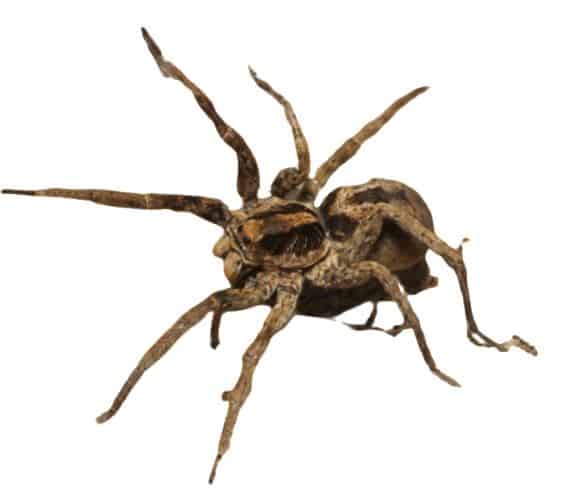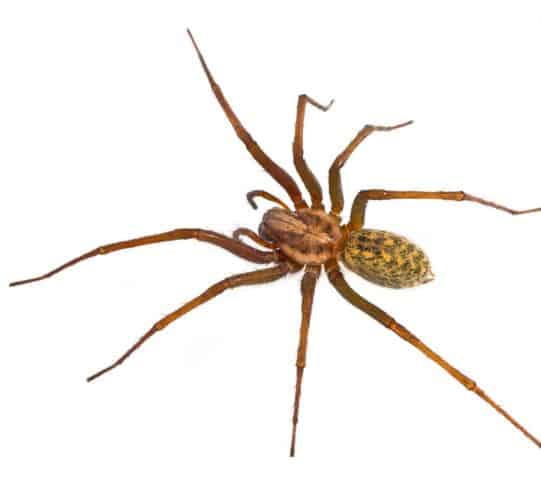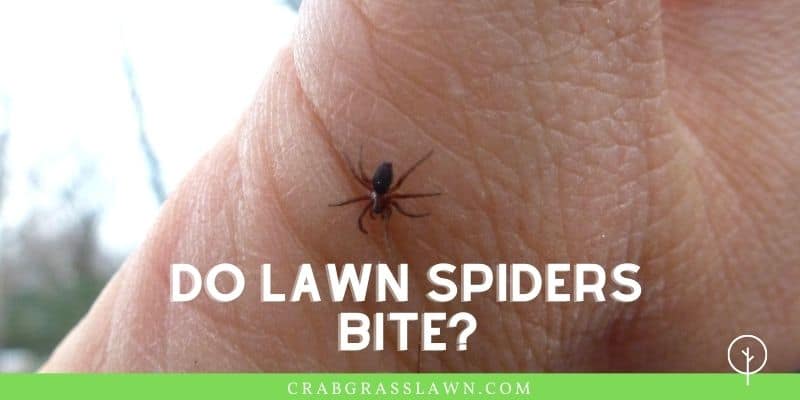I’ve often found grass spiders in my lawn and garden. Part of the funnel weaver family, they are known for their distinctive webs, shaped like a funnel and are typically brown or gray with striped markings on their abdomens.
Quick Answer
If you’ve experienced a grass spider bite and wondering if grass spiders are poisonous and dangerous, the answer is no. Even though grass spiders are equipped with venom to subdue their prey, their bites are not considered dangerous or poisonous to humans.
Jump to: the best ways to get rid of spiders in your yard.

Lawn Spiders Identification
There may be different types of spiders on your lawn. Identifying them is very important as it will help you distinguish the poisonous vs. the non-poisonous ones. I’ll help you identify the features that distinguish the various spiders commonly found in lawns and backyards.
1. Grass Spider (Agelenopsis spp)
Female grass spiders measure between 10 and 20 millimeters and the males from 9 to 18 millimeters in length, with the hind spinnerets prominent and distinct. The easiest way to identify this spider is by its dark bands running on the sides of the cephalothorax.
The grass spider is known to be a funnel-web builder. You’ll easily know your yard and lawn has them by noticing the little funnel-like webs they build in the grass. They may use grass blades to build their funnel webs in between them.
The web constructed by grass spiders in your lawn is not sticky. To compensate for this, the spider runs very fast. Sometimes, unsuspecting insects wander into the funnel and get themselves entangled in the web.

You might start to notice these little creatures enter your house as winter approaches. This is because they are escaping the low temperatures outside and opting for the warmth in the house.
This should not scare you because grass spiders are not dangerous to humans. They will die with the onset of winter because of the harsh weather conditions.
2. Wolf Spider
The wolf spider is often mistaken for the grass spider because of the similarity in the thoracic stripes. Those of wolf spiders are thick and more pronounced.
One of the major differences between wolf spiders and grass spiders in your lawn is that wolf spiders do not spin webs. Instead, they burrow small holes in the yard where they hide and wait for prey to come nearby and attack it.
Wolf spiders are fast-moving predators and do not need webs to catch prey. Their speed, sharp eyesight, and spiky legs make them among the top predatory spiders on the lawn.

Being hunters, you’ll easily find wolf spiders on your lawn because of the insect activity in the grass. Grasshoppers and other insects move and feed on your turf, making it the perfect hunting place for wolf spiders.
3. Hobo Spider
Like grass spiders, hobo spiders are a species of funnel-web spiders that can easily be found in your home – around yards and lawns. They’re common in the northwestern parts of the United States.
It is hard to identify the hobo spider because it appears to have long legs, a brown body, and a grayish abdomen, sometimes with slight yellow markings. These are typical characteristics of many species of spiders that may be found in your yard. But you can tell hobo spiders apart with a unique pattern on their abdomen – a series of chevron-shaped markings.

If you wake up to a lawn dotted with small webs all over the place, chances are hobo spiders have infested it.
This spider is commonly confused with other spiders because it has varying shades of brown. You might even think it is a wolf spider or even a brown recluse spider.
Note that if there are shrubs, trees, and bushy areas surrounding your lawn and yard, there may be many other types of spiders hunting in your lawn than the ones we’ve identified above.
Are Grass Spiders Poisonous and Dangerous?
The American grass spider produces toxins that can quickly paralyze their prey. Their prey are mostly small insects found in the lawn or grassy areas. As a homeowner, your worry is knowing whether the grass spider’s bite is poisonous and dangerous to your health.
- Grass spiders may bite but their venom does not affect humans.
- Wolf spiders can bite especially when disturbed. The bite will hurt but it is not life-threatening.
- Hobo spiders hardly attack people unless provoked. They’re aggressive hunters but not to human beings. When they bite, their venom is fairly dangerous.
Most of us like playing lawn and yard games. If you think your lawn is infested with spiders, it might be dangerous because you’ll be risking spider bites. Some spider bites can be painful and dangerous. If you suspect you’ve been bitten by a venomous spider, seek immediate medical attention.
Do Grass Spiders Bite?

Wolf spiders are known to bite especially when disturbed. However, they are not aggressive and will hardly bite you if not disturbed. These spiders are venomous, but their bites will hardly require treatment.
Hobo spiders don’t bite humans unless provoked. Some earlier studies have shown that their bites can cause unwanted symptoms in humans. However, later studies have shown that the bite from a hobo spider is not medically dangerous.
Grass spiders are not expected to bite. However, when under duress, they may bite even though they’re not poisonous.
Note that your lawn may be inhabited by other types of spiders other than the three I’ve discussed above.
What Do Spider Bites Look Like?
Grass spider bites are similar to those of regular home spider bites. Identifying a grass spider bite on human skin is easier if you seen the spider because the symptoms may not show up for a few hours later.
Key signs of a grass spider bite include:
- Red welts
- Swelling
- Skin damage
- Red or purplish blisters
- Itching or rash
- Rashes
Spider bites might hurt but in most cases no more than bee stings and not for more than an hour or so. However, the level of pain may vary depending on the type of spider such as venomous spiders. Check the Mayo Clinic guide on identifying a spider bite.
What Are the Symptoms of a Grass Spider Bite?
Grass spider bites may cause symptoms like redness, pain or swelling but these are the same symptoms caused by other bug bites, making it a bit tricky to determine whether it was an actual grass spider that bit you.
You should get in touch with your healthcare provider if you experience:
- A racing pulse or other heart problems
- Difficulty breathing
- Severe muscle pain, cramps, and/or weakness
- Nausea and vomiting
- Signs of infection like fever
- Severe problems or vision problems
How Do You Treat Grass Spider Bites?
There are several at-home remedies you can try for a grass spider bite. Most of these remedies can minimize pain and discomfort and speed up healing. Natural home remedies include:
- Lavender oil and rose oil to reduce pain
- Chamomile helps reduce skin inflammation
- Aloe vera gel to provide relief from irritation and other symptoms
Before applying any of the aforementioned treatments for spider bites:
- Make sure you clean the wound
- Next, put some ice cubes or crushed ice in a plastic bag, and hold it on the wound to reduce the pain
- Apply peroxide or rubbing alcohol to disinfect the wound
- Mix baking soda, bleach, and water but take note that this method can be quite painful
- If you have plantain wounds, they can be used as a natural cleaning agent. Simply bandage them to the bite site and leave them there for a few hours before removing them
- You can use peppermint oil – a natural chemical that helps reduce the swelling and increase blood circulation to the wounded area
- Rub deodorant on the affected area to reduce itching and irritation, two of the most common symptoms of spider bites.
Do Grass Spiders Jump?
Grass spiders are fast-moving spiders that seek protection from falling temperatures and are only aggressive when their web is approached.
Grass spiders only leap on their victim when a prey wanders into grass spider webs, and injects the victim with venom.
Grass spiders are shy creatures that have small spider fangs, making it difficult to penetrate human skin. But those who have thin skin like babies and the elderly are at greater risk of a grass spider bite.
How to Protect Yourself from Grass Spiders?
Even though grass spiders aren’t a threat to humans, great chances are that you don’t want them strolling on your property. There are many easy ways to discourage grass spiders on your lawn including:
- Keeping your grass neat and short
- Removing webs and brush piles
- Avoid leaving pet food out for extended periods
- Mowing lawns frequently
Grass spiders make homes in tall grasses, weeds, and brush piles and are attracted to home food remnants. You can spray spider repellant on your clothing and exposed skin to protect yourself from grass spiders. A well-maintained yard will discourage grass spiders from staying on your lawn and property.
Can Grass Spiders Damage My Lawn?
Grass spiders are considered beneficial pests since they munch on problematic insects in your yard.
While the funnel-shaped webs of grass spiders can be unsightly, they will not cause any damage to your lawn and garden. However, it is recommended that you maintain a well=kept lawn to ward off any grass spiders or pests.
How to Get Rid of Grass Spiders in Your Lawn?
Most of the spiders in your yard are harmless. They’re usually beneficial because they prey on harmful insects such as mosquitoes. However, if you think you have some poisonous species of spiders hiding in the grass, you may want to consider remedies.
Here’s how to get rid of spiders in your lawn:
1. Apply insecticide to control insects in your lawn
Spiders in your home appear because there’s plenty of food around the yard and lawn. As I’ve already pointed out, grass spiders and other types of spiders in your lawn live off insects. So, if you have plenty of insects on your lawn, you’ll have spiders crawling around as well.
To get rid of spiders in your lawn, you want to control insects by applying an insecticide.
- One of my favorite treatments for lawns is the Control Solutions Bifen Granules which contain an insecticide.
- You can also use the EcoSmart Insect Killer which is made of organic ingredients and won’t affect your lawn, yard plants as well as pets.
Affiliate links and images pulled from the Amazon Product Advertising API on: 2025-06-29
These two insecticides can kill not only lawn spiders but also other unwanted insects in your lawn. Bifen LP Granules, for example, can kill over 100 different types of insects and remain potent for 3 months. One application can help in getting rid of spiders in your lawn over a long period.
2. Cut vegetation around your yard
Some species of spiders create their homes in dense vegetation. The reason you have a grass spider infestation in your yard is probably the overgrowing vegetation. To control and get rid of lawn spiders, trim vegetation frequently to leave the area around your home clean and well-manicured.
This will go a great deal in sending away the spiders towards the denser areas.
You also want to remove debris and leaves on your lawn as these attract insects and provide hiding room for such creatures.
3. Mow your lawn frequently
Mowing is a great way of keeping your lawn neat, making grass grow thicker, and preventing unwanted insects and animals from inhabiting your space.
To control and discourage spiders in your lawn, ensure you mow frequently at the right height. It will keep away a lot of insects that may infest your lawn frequently.
4. Remove spider webs frequently
When you wake up to grass covered in spider webs, especially when there’s dew on your lawn, it’s time to clean up. The trick is slow but works in controlling spiders on your lawn.
Here are three ways of removing spider webs that work best for me:
- Use a sprinkler at high pressure to destroy and remove spider webs on your lawn as you water the grass.
- Using a broom, gently sweep the spider webs off the grass. Ensure you do this carefully so as not to damage the grass blades in your lawn.
- You can also use a vacuum or leaf blower to get rid of spider webs on your lawn. It works.
5. Clean up your yard
Food crumbs and residue left behind by sugary drinks are food for ants, flies, and other small insects. When ants infest your lawn due to such food residue, you should expect spiders to infest the area as well because they come hunting these small insects.
How to Get Rid of Grass Spiders in Your House?
If grass spiders have found their way into your house, there’s no need to break a sweat just yet as there are a few ways to tackle the issue.
It’s important to vacuum your house regularly and more thoroughly to remove any food particles, grass spider habitats, and egg sacs.
Place spider treatments such as MaxGuard Spider + to keep your house free of spiders. You can even replace your existing lights with yellow bulbs, which are less attractive to spiders.
- ✅ OPTIMAL SOLUTION: Keeping your house free of spiders is simple with our professional-grade Spider + Insect Traps. Our traps will capture and kill Hobo, Black Widow, Brown Recluse, American House, Yellow Sac, Wolf, and Jumping Spiders.
- ✅ HOW THEY WORK: Unlike other chemical-based solutions, our traps utilize a non-toxic industrial-grade adhesive and feature a dark-colored interior to better attract, catch and kill all species of spiders.
- ✅ NON-TOXIC & INSECTICIDE-FREE: Made with an industrial-grade super sticky adhesive that's 100% Non-toxic. Our traps are safe for usage throughout your home.
Affiliate links and images pulled from the Amazon Product Advertising API on: 2025-06-30
FAQs
Should You Kill Lawn Spiders and Insects?
While lawn spiders may be unwanted, it is important to know that other insects that aren’t harmful to your grass inhabit the lawn. Spraying an insecticide can eliminate the spiders, but may also do a lot more damage than you think.
The toxin in insecticide can seep through the soil and kill important organisms in the soil, slowing down the process of decomposition and organic fertilizer release.
Are Grass Spiders Poisonous to Dogs?
Grass spiders aren’t a threat to dogs but you still have to be careful. If your dog is bitted by a grass spider and displays symptoms such as a fever, rash restlessness, or swelling, you should call your vet immediately.
Are the Sparkles in the Grass Spiders?
There can be sparkles in grass spiders at night. Grab a powerful flashlight and put it over your forehead with the light facing towards your lawn and you should see sparkling little objects interwoven in the grass – grass spiders.
What Are the Spider Webs on My Grass?
The spider webs on your grass aren’t necessarily created by grass spiders or don’t indicate the presence of a grass spider habitat. These tiny web-like threads could be a fungus called mycelia, which generally disappears the day it starts to get warm.
Other types of fungi look like spider webs including dollar spot fungus, Rhizoctonia solani, and Pythium blight.
If left untreated, these fungi can lead to bigger problems. Horizontal circular webs are usually created by grass spiders but as mentioned earlier are usually harmless to your grass neither are grass spiders dangerous to humans.
Final Thoughts
Grass spiders aren’t poisonous or dangerous but are in fact ecologically beneficial. However, the presence of grass spiders indicates an unkept lawn, so it’s best to maintain your lawn to get rid of these male and female grass spiders and prevent the onset of harmful pests in your lawn.
You may be interested in…
How to Get Rid of Waterbugs? 10 Natural Ways
Check out more guides on lawn care, maintenance and reviews.
Hi, Alex Kuritz here. Growing up I remember that my family had one of the best lawns in the neighborhood. Richly green and lush. I did a lot as I grew up in terms of caring and tending for not only my family’s lawn but also my neighbors. I can say I have years of experience, and I am here to share it with you.







We have an infestation of grass spiders (I think). They seem to be here year round though. We have noticed them change from the brown colour to a black (which is why I question the type of spider).
We keep the grass very short with no other yard scraps, and have tried diatamatious earth as well, but have not been successful with getting rid of them. Our yard is very large so sprinkling diatamatious earth everywhere is a very time consuming operation, and we are looking for something quicker that actually has positive results.
Any suggestions would be SO helpful.
I think I was bitten by one and literally paralyzed my leg for a whole day had to use crutches and u could see my leg was really swollen at the beginning with fang marks went away after a day
Holy moly….These little buggers can really do some damage. I hope you are better by now.